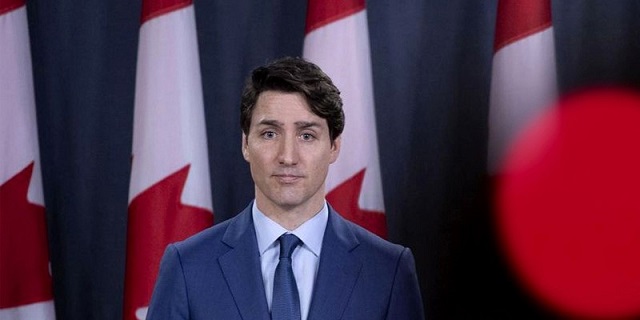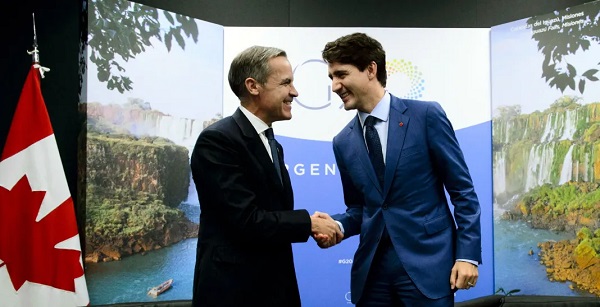Business
Prime minister rejects ‘austerity’ despite massive debt and dismal economic growth

From the Fraser Institute
By Grady Munro and Jake Fuss
Adjusting for population growth and inflation, the Trudeau government has recorded the five-highest years (2018-2022) of per-person spending in Canadian history, and is on track to record a sixth.
This week, at the Liberal cabinet retreat in Montreal, Prime Minister Justin Trudeau told reporters he’s against “austerity and cuts” and believes his government must “invest” to “create greater growth” in the economy, thus dashing hopes for any meaningful spending restraint in the upcoming federal budget.
But evidence shows the government’s current plan has not helped the economy despite the prime minister’s claims. Rather than double-down on a failed strategy of higher spending, taxes and borrowing, the Trudeau government should change direction immediately.
Let’s look at the evidence.
According to its latest fiscal projections, the federal government will spend $449.8 billion on programs and services in 2023/24—up 75.5 per cent (nominally) from 2014/15 when program spending was $256.2 billion. Adjusting for population growth and inflation, the Trudeau government has recorded the five-highest years (2018-2022) of per-person spending in Canadian history, and is on track to record a sixth. But have we seen a corresponding increase in economic growth?
No, in fact Canada has experienced an economic growth crisis for the last decade.
One of the best ways to measure economic growth is to use inflation-adjusted per-person gross domestic product (GDP), which provides the broadest measure of living standards for Canadians. According to a recent study by Philip Cross, former chief economic analyst at Statistics Canada, between 2013 and 2022 Canada’s per-person GDP (inflation-adjusted) grew at its slowest pace since the 1930s. Moreover, economic growth in Canada has fallen well behind growth in the United States, showing that Canada’s stagnation was not inevitable.
And there’s little room for optimism. According to OECD estimates, Canada will have the slowest growth in per-person GDP among advanced economies from 2020 to 2030 and 2030 to 2060.
Simply put, the data show that increased government spending has not produced greater prosperity for Canadians.
Indeed, rather than “invest” in Canadians, the Trudeau government has burdened Canadians with mountains of debt. The Trudeau government has yet to balance the budget, despite campaign promises, and this year will likely run its ninth consecutive deficit. Nearly a decade of uninterrupted deficits has increased the federal debt by $941.9 billion. This not only imposes costs on Canadians today—primarily through higher debt interest costs—but also increases the tax burden on future generations who are ultimately responsible for paying off today’s debt.
If the Trudeau government needs a blueprint for reform, it can find it within its own party, which has a history of spending reductions and strong economic growth.
During the mid-1990s, the Chrétien Liberal government introduced meaningful spending reductions that ultimately balanced the federal budget in 1997, marking the first federal budget surplus in nearly 30 years. In addition to spending reductions, the Chrétien government also introduced tax relief and other growth-enhancing policies. And the results were immediate.
Between 1997 and 2007, Canada’s average annual increase in per-person GDP (inflation-adjusted) was 2.2 per cent, which was higher than the OECD average. During the same time period, Canada’s average rate of employment growth was nearly double the average in the OECD and the United States. And the national poverty rate fell from 7.8 per cent in 1996 to 4.9 per cent in 2004. Overall, the Canadian economy outperformed many other industrialized economies during this time and living standards improved for Canadians—despite reductions in government spending.
Despite claims by Prime Minister Trudeau, less government spending (not more) is necessary to help reverse the trend of stagnant economic growth. The Trudeau government should recognize that the current plan isn’t working and change course in its upcoming budget.
Authors:
Business
Canada is failing dismally at our climate goals. We’re also ruining our economy.

From the Fraser Institute
By Annika Segelhorst and Elmira Aliakbari
Short-term climate pledges simply chase deadlines, not results
The annual meeting of the United Nations Conference of the Parties, or COP, which is dedicated to implementing international action on climate change, is now underway in Brazil. Like other signatories to the Paris Agreement, Canada is required to provide a progress update on our pledge to reduce greenhouse gas (GHG) emissions by 40 to 45 per cent below 2005 levels by 2030. After decades of massive government spending and heavy-handed regulations aimed at decarbonizing our economy, we’re far from achieving that goal. It’s time for Canada to move past arbitrary short-term goals and deadlines, and instead focus on more effective ways to support climate objectives.
Since signing the Paris Agreement in 2015, the federal government has introduced dozens of measures intended to reduce Canada’s carbon emissions, including more than $150 billion in “green economy” spending, the national carbon tax, the arbitrary cap on emissions imposed exclusively on the oil and gas sector, stronger energy efficiency requirements for buildings and automobiles, electric vehicle mandates, and stricter methane regulations for the oil and gas industry.
Recent estimates show that achieving the federal government’s target will impose significant costs on Canadians, including 164,000 job losses and a reduction in economic output of 6.2 per cent by 2030 (compared to a scenario where we don’t have these measures in place). For Canadian workers, this means losing $6,700 (each, on average) annually by 2030.
Yet even with all these costly measures, Canada will only achieve 57 per cent of its goal for emissions reductions. Several studies have already confirmed that Canada, despite massive green spending and heavy-handed regulations to decarbonize the economy over the past decade, remains off track to meet its 2030 emission reduction target.
And even if Canada somehow met its costly and stringent emission reduction target, the impact on the Earth’s climate would be minimal. Canada accounts for less than 2 per cent of global emissions, and that share is projected to fall as developing countries consume increasing quantities of energy to support rising living standards. In 2025, according to the International Energy Agency (IEA), emerging and developing economies are driving 80 per cent of the growth in global energy demand. Further, IEA projects that fossil fuels will remain foundational to the global energy mix for decades, especially in developing economies. This means that even if Canada were to aggressively pursue short-term emission reductions and all the economic costs it would imposes on Canadians, the overall climate results would be negligible.
Rather than focusing on arbitrary deadline-contingent pledges to reduce Canadian emissions, we should shift our focus to think about how we can lower global GHG emissions. A recent study showed that doubling Canada’s production of liquefied natural gas and exporting to Asia to displace an equivalent amount of coal could lower global GHG emissions by about 1.7 per cent or about 630 million tonnes of GHG emissions. For reference, that’s the equivalent to nearly 90 per cent of Canada’s annual GHG emissions. This type of approach reflects Canada’s existing strength as an energy producer and would address the fastest-growing sources of emissions, namely developing countries.
As the 2030 deadline grows closer, even top climate advocates are starting to emphasize a more pragmatic approach to climate action. In a recent memo, Bill Gates warned that unfounded climate pessimism “is causing much of the climate community to focus too much on near-term emissions goals, and it’s diverting resources from the most effective things we should be doing to improve life in a warming world.” Even within the federal ministry of Environment and Climate Change, the tone is shifting. Despite the 2030 emissions goal having been a hallmark of Canadian climate policy in recent years, in a recent interview, Minister Julie Dabrusin declined to affirm that the 2030 targets remain feasible.
Instead of scrambling to satisfy short-term national emissions limits, governments in Canada should prioritize strategies that will reduce global emissions where they’re growing the fastest.

Elmira Aliakbari
Artificial Intelligence
Lawsuit Claims Google Secretly Used Gemini AI to Scan Private Gmail and Chat Data

Whether the claims are true or not, privacy in Google’s universe has long been less a right than a nostalgic illusion.
|
When Google flipped a digital switch in October 2025, few users noticed anything unusual.
Gmail loaded as usual, Chat messages zipped across screens, and Meet calls continued without interruption.
Yet, according to a new class action lawsuit, something significant had changed beneath the surface.
We obtained a copy of the lawsuit for you here.
Plaintiffs claim that Google silently activated its artificial intelligence system, Gemini, across its communication platforms, turning private conversations into raw material for machine analysis.
The lawsuit, filed by Thomas Thele and Melo Porter, describes a scenario that reads like a breach of trust.
It accuses Google of enabling Gemini to “access and exploit the entire recorded history of its users’ private communications, including literally every email and attachment sent and received.”
The filing argues that the company’s conduct “violates its users’ reasonable expectations of privacy.”
Until early October, Gemini’s data processing was supposedly available only to those who opted in.
Then, the plaintiffs claim, Google “turned it on for everyone by default,” allowing the system to mine the contents of emails, attachments, and conversations across Gmail, Chat, and Meet.
The complaint points to a particular line in Google’s settings, “When you turn this setting on, you agree,” as misleading, since the feature “had already been switched on.”
This, according to the filing, represents a deliberate misdirection designed to create the illusion of consent where none existed.
There is a certain irony woven through the outrage. For all the noise about privacy, most users long ago accepted the quiet trade that powers Google’s empire.
They search, share, and store their digital lives inside Google’s ecosystem, knowing the company thrives on data.
The lawsuit may sound shocking, but for many, it simply exposes what has been implicit all along: if you live in Google’s world, privacy has already been priced into the convenience.
Thele warns that Gemini’s access could expose “financial information and records, employment information and records, religious affiliations and activities, political affiliations and activities, medical care and records, the identities of his family, friends, and other contacts, social habits and activities, eating habits, shopping habits, exercise habits, [and] the extent to which he is involved in the activities of his children.”
In other words, the system’s reach, if the allegations prove true, could extend into nearly every aspect of a user’s personal life.
The plaintiffs argue that Gemini’s analytical capabilities allow Google to “cross-reference and conduct unlimited analysis toward unmerited, improper, and monetizable insights” about users’ private relationships and behaviors.
The complaint brands the company’s actions as “deceptive and unethical,” claiming Google “surreptitiously turned on this AI tracking ‘feature’ without informing or obtaining the consent of Plaintiffs and Class Members.” Such conduct, it says, is “highly offensive” and “defies social norms.”
The case invokes a formidable set of statutes, including the California Invasion of Privacy Act, the California Computer Data Access and Fraud Act, the Stored Communications Act, and California’s constitutional right to privacy.
Google is yet to comment on the filing.
|
|
|
|
Reclaim The Net is reader-supported. Consider becoming a paid subscriber.
|
|
|
|
-

 Alberta2 days ago
Alberta2 days agoNational Crisis Approaching Due To The Carney Government’s Centrally Planned Green Economy
-

 Carbon Tax1 day ago
Carbon Tax1 day agoCarney fails to undo Trudeau’s devastating energy policies
-

 Business1 day ago
Business1 day agoThe UN Pushing Carbon Taxes, Punishing Prosperity, And Promoting Poverty
-

 Agriculture2 days ago
Agriculture2 days agoFederal cabinet calls for Canadian bank used primarily by white farmers to be more diverse
-

 Health1 day ago
Health1 day agoNEW STUDY: Infant Vaccine “Intensity” Strongly Predicts Autism Rates Worldwide
-

 Business1 day ago
Business1 day agoClimate Climbdown: Sacrificing the Canadian Economy for Net-Zero Goals Others Are Abandoning
-

 Great Reset2 days ago
Great Reset2 days agoCanadian government forcing doctors to promote euthanasia to patients: report
-

 Artificial Intelligence24 hours ago
Artificial Intelligence24 hours agoLawsuit Claims Google Secretly Used Gemini AI to Scan Private Gmail and Chat Data






